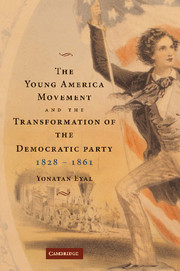Book contents
- Frontmatter
- Contents
- Acknowledgments
- Introduction: The Spirit of Young America
- 1 Orthodox Jacksonianism, 1828–1844
- 2 Trade and Improvements: The Economic Orientation of Young America Democrats
- 3 Rails, Canals, and a New Commercial Spirit
- 4 Young America Democrats and the Revolutions of 1848
- 5 A New International Consciousness
- 6 The Fires of Perfection Revisited
- 7 The Antislavery Democracy
- 8 New Democrats and the Coming of the Civil War
- Conclusion: Lincoln on Young America
- Index
Conclusion: Lincoln on Young America
Published online by Cambridge University Press: 31 July 2009
- Frontmatter
- Contents
- Acknowledgments
- Introduction: The Spirit of Young America
- 1 Orthodox Jacksonianism, 1828–1844
- 2 Trade and Improvements: The Economic Orientation of Young America Democrats
- 3 Rails, Canals, and a New Commercial Spirit
- 4 Young America Democrats and the Revolutions of 1848
- 5 A New International Consciousness
- 6 The Fires of Perfection Revisited
- 7 The Antislavery Democracy
- 8 New Democrats and the Coming of the Civil War
- Conclusion: Lincoln on Young America
- Index
Summary
We have all heard of Young America. He is the most current youth of the age. Some think him conceited, and arrogant; but has he not reason to entertain a rather extensive opinion of himself? Is he not the inventor and owner of the present, and sole hope of the future?
So began Abraham Lincoln's address to a “Young Men's Association” in Illinois. Speaking in 1859, Lincoln felt the benefit of hindsight. He knew that the era of the New Democracy had passed, and that the slavery issue now took center stage. Sectional politics had for several years eclipsed the spirit of Young America, as battles on the Kansas plains, assaults on the Senate floor, and the reorganization of political parties amply demonstrated.
As an obscure Whig legislator Lincoln had disparaged Young America. He opposed the annexation of Texas and the Mexican War, refusing to advance the blustery romantic nationalism that inspired Stephen Douglas and his circle. By 1859, when he delivered this address, Lincoln was still a relative nobody. He lost a high-profile U.S. Senate race to Douglas and had only served one unremarkable term in the federal House of Representatives during the late 1840s. But his speech betrays a poignant, almost-tragic understanding that the Young America moment had passed and that the future lay on his, not Douglas's, side. Lincoln ridiculed Young America Democrats, but in some ways he admired them.
- Type
- Chapter
- Information
- The Young America Movement and the Transformation of the Democratic Party, 1828–1861 , pp. 229 - 236Publisher: Cambridge University PressPrint publication year: 2007



